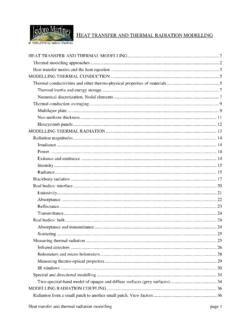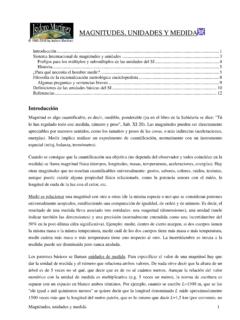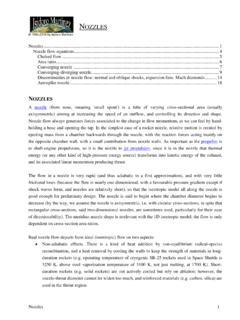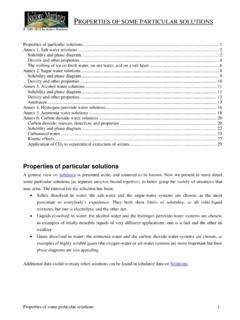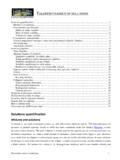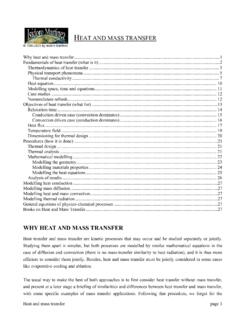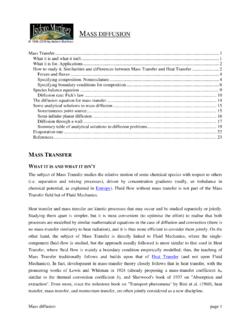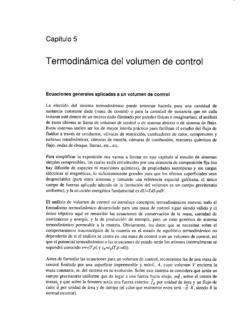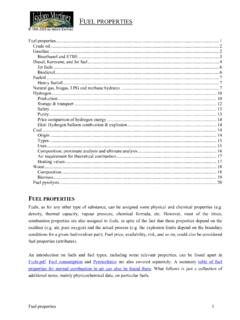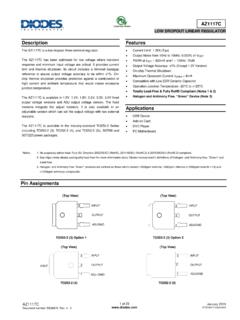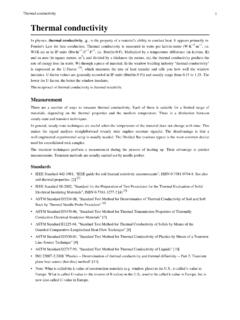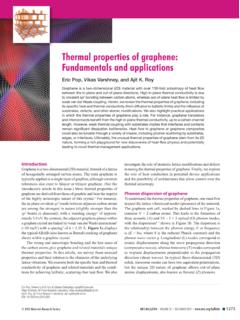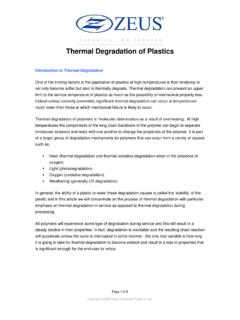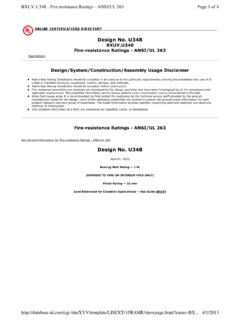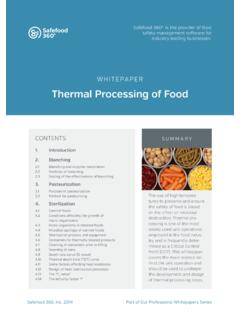Transcription of Thermal effects on materials - UPM
1 Thermal effects ON materials . Thermal effects .. 2. materials . Types and properties .. 3. Classification of Thermal effects on materials .. 4. Types of material properties .. 5. Refractory materials .. 6. Heating techniques .. 7. Thermal properties .. 8. Thermodynamic .. 8. Thermophysical .. 10. 13. Measurement of Thermal properties .. 13. Temperature effects on mechanical properties .. 14. 14. Displacement .. 15. Strain .. 15. Stress .. 16. Constitutive relations .. 16. Thermoelastic deformation and 21. Temperature-dependant shape-memory materials .. 23. Plasticity. Plastic deformation and bending .. 25. Thermoplastic shrinkage. Heat line technique or line heating method .. 25. Heat joining. Welding distortions .. 26. Heat cutting .. 27. Heat treatment .. 28. Recrystallisation temperature .. 28. Thermal creeping .. 29. Fracture.
2 30. Brittle-ductile transition .. 30. Surface cracks on anodised 31. Thermal effects due to manufacturing or 31. Phase diagrams .. 31. Phase change kinetics, nucleation and segregation .. 32. Shrinkage on casting .. 34. Heating during solid friction .. 35. Heating during 36. Cutting energy .. 36. Cutting power. Geometry and variables .. 37. Cutting 38. Dimensional effects of machining .. 39. Cutting 39. Thermal manufacturing .. 39. Thermal degradation .. 40. Thermal protection. Ablation .. 40. Thermal effects as forensic evidence .. 41. Thermal analysis .. 41. Thermal analysis techniques .. 42. Reference points in Thermal analysis .. 43. References .. 43. Thermal effects on materials 1. Thermal effects . In the broad sense, Thermal effects are those caused by a redistribution of internal energy in a system, and they may be grouped in natural and artificial (see Introduction to Thermodynamics).
3 More often, however, instead of considering a generic compound system out of equilibrium, a system at equilibrium is assumed, and Thermal effects are understood as those caused by a temperature variation forced from outside or due to internal processes. Most of the times, both Thermal effects ' ( Thermal response) and Thermal causes' ( Thermal load) are included in the study. Thermal behaviour of materials is a broader subject, more directly related to their general Thermal properties than to Thermal effects of specific interest; heat transfer processes, or the fact that when energy is added to a material it gets hotter, are general Thermal behaviour of matter, usually not included in the analysis of Thermal effects . Thermal effects on materials may be used advantageously (all kind of thermometers relay on them), or a nuisance (shape and dimension distortions due to heating or cooling, malfunction of electronic equipment).
4 Most of the times, Thermal effects are understood to focus just on materials (understood as solid materials ), and to deal with the effects of a non-comfort working temperature (cold or hot) on some material properties (structural, electronic, etc.), including the Thermal processes used to produce, change or dispose of those materials . Sometimes it is also said the effect of heat on materials ', meaning the effect of heating so as to increase the internal energy. Of course, the effects of cooling are also relevant Thermal effects . The traditional Thermal effects are: Phase change, basically melting and boiling (phase transition temperatures). Glass transition temperature. Dimensional change, basically Thermal expansion (in general, contraction if negative). Elasto-plastic changes, due to Thermal stresses. Brittle/ductile transition temperature.
5 Chemical change, decomposition, oxidation, ignition. Other physical changes as drying, segregation, outgassing, colour change, etc. Thermal effects due to non- Thermal causes: frictional heating, electrical heating, chemical heating, nuclear heating. A general idea to keep in mind is that materials cannot resist very high temperature, say over 1000 K, without decomposition; materials resistant to high temperatures (from 1000 K to 3000 K) are called refractories. On the other hand, the effect of very low temperatures (cryogenics) is mainly an increase in fragility (most materials break or even shatter after a knock at cryogenic temperatures), what may help on hard-metals machining; cryogenic cooling of metals increase their resistance to wear. An overview of some possible classification of Thermal effects helps to centre the field, although only a selected mix of topics, in a structured layout but with different levels of detail, is covered below.
6 Thermal effects on materials 2. materials . TYPES AND PROPERTIES. materials are solid bodies with intrinsic properties (apart of the shape) that render them useful, mainly for structures, but also for services ( isolation, piping), electronics, optics, bioengineering, Fluids are treated as intermediate states here (in materials processing). A substance is a chemically identified pure or mixture matter (solid or fluid). Matter is what has mass ( everything except perfect vacuum). materials are usually classified in four categories (basically depending on the type of chemical bond): Metals (metallic bonds, polycrystalline solids). They are obtained by high-temperature reduction of their ores with carbon (as for iron in a blast furnace), or by high-temperature electrolysis of their molten ores (as for aluminium). They are the materials most used, and amongst them ferrous metals (90%; and non-ferrous being mostly alloys of Al, Cu, Ni and Ti).
7 They are ductile, heavy, and good electrical and Thermal conductors. Ceramics (ionic bonds, amorphous inorganic solids). They are the most ancient (stones, bricks, glasses), usually made by previous calcination of raw materials (making cement powder) and final curing of composite mixtures, concrete is made with cement, sand and gravel (plus water). They are resistant to wear (but not to impact), lighter than metals, insulating, porous and fragile (very sensitive to flaws). Polymers (covalent bonds, amorphous organic solids). They are organic and non-crystalline soft solids artificially obtained from petroleum in the xx c., by moderate-temperature addition or condensation of organic macromolecules ( very large molecules with very simple composition, as polyethylene, the most used, -(-C2H4-)n- with n between 100 and 1000 and molar mass M= kg/mol.)
8 Plastics, mouldable synthetic matter, is often used as a synonym of polymers. Composites (a heterogeneous combination of the former three). Examples: wood (lignine in cellulose), bone, adobe (straw in clay), paper (lignine in cellulose), concrete (gravel in cement), reinforced concrete (steel rods in concrete). There are many types of material properties (see below); Table 1 presents a broad comparison for the three main material types. Traditionally, Material Science and Engineering deals with the microscopic analysis (atoms, molecules and bonds), the microstructure (mesoscale), the macroscopic properties, the processing techniques and the applications, usually divided in the traditional material types: metals, ceramics, polymers and composites. Table 1. Property comparison for the different types of materials (typical value and range).
9 Property Metals Ceramics Polymers Density [kg/m ]3 8000 ( ) 4000 ( ) 1000 ( ). Thermal expansion [1/K] 10 10 (1 10 .. -6 -6. 10 10 (1 10 .. -6 -6. 100 10-6 (50 100 10 ). -6. 20 10 ). -6. 500 10-6). Thermal capacity cp [J/(kg K)] 500 ( ) 900 ( ) 1500 ( ). Thermal conductivity k [W/(m K)] 100 ( 500) 1 ( 20) 1 ( 20). Melting (or yield) point Tm [K] 1000 ( ) 2000 ( ) 400 ( ). Elastic Young's modulus E [GPa] 200 ( ) 200 ( ) 1 ( ). Poisson's ratio ( ) ( ) ( ). Break strength break [MPa] 500 ( ) 100 ( 50 ( tensile). Thermal effects on materials 3. tensile) ( compr.). ( compr.). Hardness Medium High Low Machinability Good Very poor Very good Thermal shock resistance Good Poor Very poor Thermal creep resistance Poor to medium Excellent Very poor Electrical conductivity High Very low Very low Chemical resistance Low to medium Excellent Good In general, an in what follows, Thermal effects on materials usually refer to Thermal effects on metallic materials because metals are the back horse of industrial materials .
10 It may be argued also that metals are richer in Thermal effects than ceramics, but, in the future, Thermal effects on polymers may take the centre of the study, since it is clear that polymers are more sensitive to temperature than metals. However, this Thermal sensitivity of polymers is feared nowadays as a handicap ( their low softening temperature, their small Thermal conductivity), whereas metals are strong and conducting, and ceramics are strong and insulating. Composites, as most natural materials are, seem to be the most promising. Polymers usually have low Thermal conductivity, but it can be greatly enhanced by adding conductive powders ( bakelite may change from k=1 W/(m K) to k= W/(m K) with 55 % by volume of graphite), and strongly depends on their degree of crystallinity, because the Thermal conductivity in polymers is mostly due to so-called phonon transport that is very efficient along the crystallinity axes but substantially reduced by various scattering processes in other directions.
